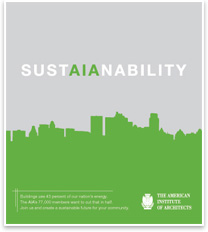
AIA Launches Green Building Tool Kit for Mayors Summary: The AIA and the United States Conference of Mayors (USCM) are working together to encourage city leaders to take a strong stance in favor of promoting integrated and high-performance building design with a goal of reaching a 50 percent fossil fuel reduction by 2010 and carbon neutral buildings by 2030. To that end, the AIA launched a toolkit that offers an overview of green building issues, sample ordinance language that has already been used effectively, and real-world examples of what communities are already doing to pursue green building programs.
The tool kit will also be available through AIA local components to be shared with mayors and planning officials. In addition, AIA Vice President Norman Strong, FAIA, participated in a panel, “Meeting the 2030 Building Challenge Through Design Ratings and Innovative Programs,” to help the mayors navigate the options for achieving reduction targets. Architects and green buildings Currently, the vast majority of this energy is produced from nonrenewable, fossil-fuel resources, and the amount of energy used to erect and operate buildings has been increasing dramatically. If current trends continue, U.S. annual energy consumption is projected to increase by 37 percent and greenhouse gas emissions by 36 percent in the next 20 years. Utility costs have also been on an upward trajectory, with electricity costs rising throughout the country. The Pew Center on Global Climate Change report, “Towards a Climate Friendly Built Environment,” provides an excellent overview of the current environmental impact of building and construction and the profound effect that green buildings can have on the future health of our communities and planet.
Creating green communities “The AIA is active at all levels of government to promote legislation, codes, appropriations, research, and initiatives that support sustainable buildings and communities,” says Paul Mendelsohn, vice president, Government and Community Relations. “Our work with the nation’s mayors to raise awareness of these issues has been extremely encouraging so far, and we are now working in tandem with them to implement real-world design solutions at the community level.” Says USCM President and Dearborn (Mich.) Mayor Michael A. Guido: “The nation’s mayors have become increasingly aware of the need to take action to mitigate the impact of global warming in our cities. Because buildings account for nearly half of the energy used in this nation, mayors are taking the lead on this issue and are committed to finding innovative ways to make all buildings carbon neutral by 2030. Our partnership with the AIA is invaluable because it lends practical expertise to this effort.”
|
||
Copyright 2006 The American Institute of Architects. All rights reserved. Home Page |
||
news headlines
practice
business
design
Recent related
› Mayors Adopt AIA Position on Sustainability
› “Architecture 2030” Web Site Takes on Global Warming
› Mazria Asks “Where Are We Heading?” in New AIA eClassroom Course
For more information, e-mail the AIA Government Advocacy Team.
Visit the Conference of Mayors’ Web site to see the Green Tool Kit.

 The AIA launched the “SUSTAIANABILITY 2030 Toolkit, an Introduction to Green Building,” at the mayors’ 2nd National Summit on Energy and the Environment October 26. Available on CD and DVD, the guide features:
The AIA launched the “SUSTAIANABILITY 2030 Toolkit, an Introduction to Green Building,” at the mayors’ 2nd National Summit on Energy and the Environment October 26. Available on CD and DVD, the guide features: